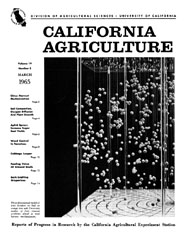|
|||
|
|||

Three-dimensional model of fruit location on half an orange tree aids University studies of fruit removal problems aimed at total harvest mechanization,
March 1965
Volume 19, Number 3 |
|||
|
University of California, 1301 S. 46th St., Bldg. 478 Richmond, CA
|